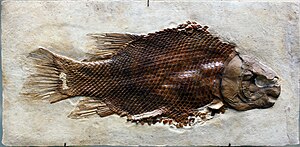Scheenstia
| Scheenstia Temporal range: Late Jurassic–Early Cretaceous,
| |
|---|---|

| |
| Fossil specimen of S. maxima | |
| Scientific classification | |
| Kingdom: | Animalia |
| Phylum: | Chordata |
| Class: | Actinopterygii |
| Order: | Lepisosteiformes |
| Family: | †Lepidotidae |
| Genus: | †Scheenstia López-Arbarello & Sferco, 2011 |
| Type species | |
| Scheenstia zappi López-Arbarello & Sferco, 2011
| |
| Species[1] | |
|
†S. mantelli (Agassiz, 1833) | |
Scheenstia is an extinct genus of neopterygian ray-finned fish from the Late Jurassic–Early Cretaceous of Europe. Fossils have been found in both marine and freshwater environments.[2][3]
Most species of the genus were previously referred to the related genus Lepidotes, but all Late Jurassic–Early Cretaceous species of that genus have since been re-classified as Scheenstia following detailed phylogenetic analysis.[1] It is a member of Lepisosteiformes meaning that is closest living relates are gars. The teeth of Scheenstia are low and rounded, and were likely used for crushing hard shelled organisms (durophagy).[2] One species, the marine Scheenstia maximus from the Late Jurassic of Germany, could reach body lengths in excess of 1.5 metres.[1]
Classification
Scheenstia is related to the genus Lepidotes. The latter has been one of the greatest actinopterygian wastebasket taxa, with one 2012 study finding species referrable to a minimum of three different and distantly related genera. Scheenstia is also related to Isanichthys. A cladogram showing the relations of Neopterygii was published in the review, and a simplified version labelling the previous species of Lepidotes is shown here.[1]
| Ginglymodi |
| ||||||||||||||||||||||||||||||||||||||||||||||||||||||||||||||||||||||||||||||||||||||||||
References
- ^ a b c d López-Arbarello, A. (2012). "Phylogenetic Interrelationships of Ginglymodian Fishes (Actinopterygii: Neopterygii)". PLOS ONE. 7 (7): e39370. Bibcode:2012PLoSO...739370L. doi:10.1371/journal.pone.0039370. PMC 3394768. PMID 22808031.
- ^ a b Leuzinger, Léa; Cavin, Lionel; López‐Arbarello, Adriana; Billon‐Bruyat, Jean‐Paul (January 2020). Smith, Andrew (ed.). "Peculiar tooth renewal in a Jurassic ray‐finned fish (Lepisosteiformes, † Scheenstia sp.)". Palaeontology. 63 (1): 117–129. doi:10.1111/pala.12446. ISSN 0031-0239.
- ^ Cavin, Lionel; Deesri, Uthumporn; Olive, Sébastien (2019-07-22). "Scheenstia bernissartensis (Actinopterygii: Ginglymodi) from the Early Cretaceous of Bernissart, Belgium, with an appraisal of ginglymodian evolutionary history". Journal of Systematic Palaeontology. 18 (6): 513–527. doi:10.1080/14772019.2019.1634649. ISSN 1477-2019.
Error: "Q293345" is not a valid Wikidata entity ID.
- Articles with short description
- Short description with empty Wikidata description
- Articles with 'species' microformats
- Taxonbars desynced from Wikidata
- Taxonbar pages requiring a Wikidata item
- Taxonbars with invalid from parameters
- Taxonbars without secondary Wikidata taxon IDs
- Lepisosteiformes
- Prehistoric ray-finned fish genera
- Cretaceous bony fish
- Mesozoic fish of Europe
- Fossil taxa described in 2011
- All stub articles
- Prehistoric ray-finned fish stubs
- Jurassic fish stubs
- Cretaceous fish stubs

